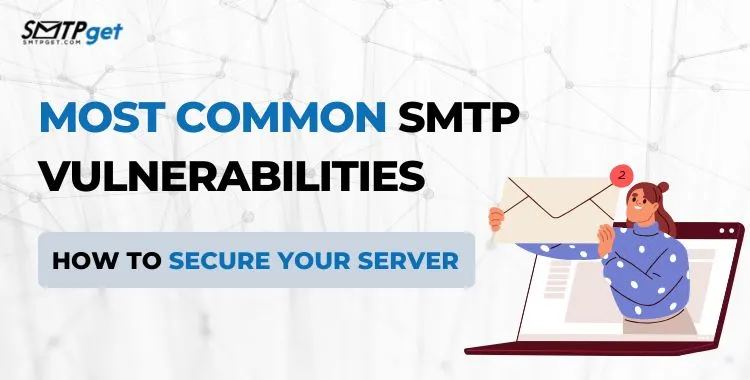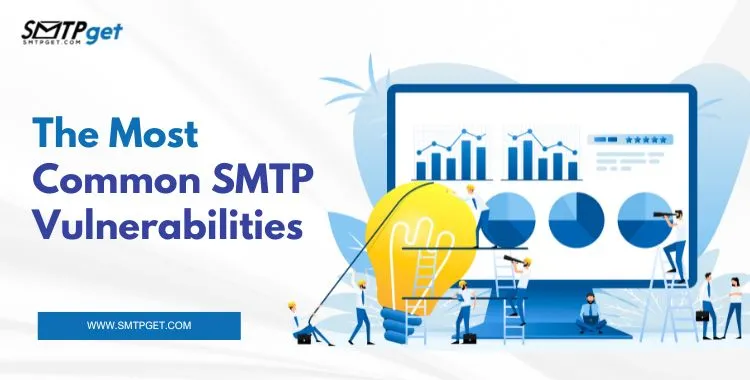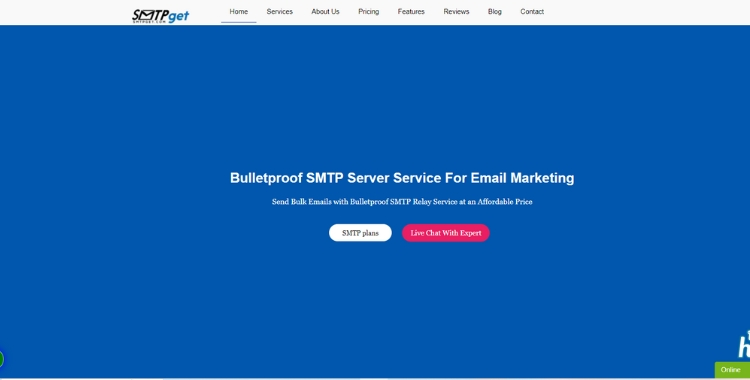SMTP is the standard for sending email messages across the Internet. But as powerful and universal as it is, SMTP vulnerabilities have become a growing concern. That’s because SMTP was designed at a time when cybercrime was virtually nonexistent. Its creators never envisioned the modern threats we see today, such as spamming, phishing, spoofing, eavesdropping, and brute-force attacks.

This lack of built-in security makes SMTP a favorite target for attackers. Whether you manage an email server for your organization or run email campaigns as a marketer, understanding and mitigating SMTP vulnerabilities is crucial to safeguarding your email infrastructure and reputation. Modern tools, like an SMTP vulnerability scanner, can help you detect misconfigurations and weaknesses such as an SMTP relay vulnerability before attackers exploit them.
What is SMTP and Why is it Important?
SMTP, or Simple Mail Transfer Protocol, is the standard protocol for sending emails. It defines how email clients and servers communicate to deliver your message from Point A to Point B.
For example:
- When you hit “Send” in Gmail or Outlook, your client contacts an SMTP server.
- The SMTP server then forwards the email to the recipient’s mail server.
- The recipient’s server delivers the message to their inbox.
Without SMTP, email simply wouldn’t work.
But here’s the catch: SMTP was designed in the early 1980s long before cyberattacks became common. It was created for a trusted, academic community. Security wasn’t a concern then. Today, this makes SMTP inherently vulnerable to security threats, including SMTP relay vulnerabilities and other critical flaws that can compromise your email systems if left unchecked.
Why is SMTP Vulnerable?
SMTP is the backbone of email communication, but it comes with significant security risks. Understanding SMTP vulnerabilities is essential to protect your email systems and maintain your domain’s reputation. SMTP server providers can help to cure from this kind of problem.

By default, SMTP has several inherent weaknesses:
- Transmits messages in plain text, which means emails can be intercepted and read by attackers while in transit. This exposes sensitive information, making data breaches more likely.
- Does not verify sender addresses, enabling email spoofing. Attackers can forge the “From” address to make it appear as if emails come from a trusted domain.
- Allows servers to forward emails without strict authentication, known as an SMTP relay vulnerability. Open relays are often abused by spammers to send large volumes of spam or malware, which can lead to your server being blacklisted.
- Does not limit connection attempts, making brute-force attacks feasible. Attackers can try endless username-password combinations until they gain unauthorized access.
These SMTP vulnerabilities are actively exploited by cybercriminals to send fraudulent emails, distribute malware, and steal confidential information. Without proper configuration and continuous monitoring, your SMTP server can quickly become a liability rather than an asset.
To mitigate these risks, it’s vital to regularly scan your servers using an SMTP vulnerability scanner. These tools help you detect open relays, misconfigurations, and outdated protocols. They can also uncover Post SMTP vulnerabilities, which may arise after installing or misconfiguring plugins or extensions, especially in WordPress environments where “Post SMTP” plugins are commonly used.
In short, ignoring SMTP vulnerabilities can result in financial loss, legal consequences, and severe damage to your email deliverability. Proactively addressing them with the right tools, policies, and monitoring systems will help you secure your email infrastructure and build trust with your recipients.
SMTP Header Injection Vulnerabilities
SMTP header injection is a type of attack where malicious users exploit improperly validated user input to inject additional SMTP headers into an email. This allows attackers to modify email fields (like To, Cc, Bcc, or Subject) or even send unauthorized emails through your application.
For example, if a web form sends emails and doesn’t sanitize user input properly, an attacker can craft input like:
test@example.com%0ABcc: victim@example.com
This appends a Bcc field to the email, sending copies to unintended recipients.
Why it’s dangerous:
- Attackers can send spam through your server, harming your reputation.
- Sensitive information may be leaked to unintended recipients.
- Your application can be abused for phishing campaigns.
How to prevent it:
- Always validate and sanitize user input in web forms.
- Disallow line breaks (\r, \n) and other special characters in email-related fields.
- Use mail libraries or APIs that handle headers securely.
SMTP header injection is a subtle but serious risk, especially for web applications that generate emails dynamically. Testing your forms and scripts for injection vulnerabilities is a crucial part of securing your email infrastructure.
The Most Common SMTP Vulnerabilities
SMTP servers are prone to several security weaknesses that attackers often exploit. Below are the most common SMTP vulnerabilities, explained in detail to help you secure your email infrastructure effectively:

1. Open Relay Misconfiguration
An open relay is an SMTP server that accepts and forwards emails from any sender to any recipient, without requiring authentication.
Why it’s dangerous:
Spammers use open relays to send huge volumes of spam through your server. This can lead to:
- Your server is being blacklisted by email providers.
- Damage to your domain’s reputation.
- Legal and regulatory consequences.
How to protect against it:
Require authentication for all outgoing emails.
Configure your SMTP server to reject unauthorized relay requests.
Use tools like MXToolbox to regularly check your server for open relay vulnerabilities.
2. Lack of Encryption (Plaintext Communication)
By default, SMTP sends emails in unencrypted, plain text. Anyone intercepting the network traffic can read the email contents, including sensitive information.
Why it’s dangerous:
Attackers can intercept usernames, passwords, confidential business data, or customer information, leading to breaches and privacy violations.
How to protect against it:
Enable TLS (Transport Layer Security) on your SMTP server.
Use STARTTLS to upgrade plaintext connections to encrypted ones.
Configure your server to refuse unencrypted connections where possible.
3. Weak or No Authentication
SMTP servers sometimes allow weak authentication methods, or worse, no authentication at all.
Why it’s dangerous:
Hackers can exploit weak credentials or simply bypass authentication, using your server to send spam, malware, or phishing emails.
How to protect against it:
- Enforce strong password policies for SMTP accounts.
- Use modern authentication mechanisms (like OAuth, where supported).
- Enable multi-factor authentication (MFA) if possible.
- Disable anonymous sending and unused accounts.
4. Email Spoofing
SMTP does not check whether the sender’s email address is genuine. Attackers can forge the “From” address to make it appear as if the email came from a trusted domain.
Why it’s dangerous:
Spoofing enables phishing attacks, financial fraud, and brand impersonation — harming your company’s trust and customer relationships.
How to protect against it:
- Publish SPF (Sender Policy Framework) records for your domain.
- Set up DKIM (DomainKeys Identified Mail) to cryptographically sign your messages.
- Enable DMARC (Domain-based Message Authentication, Reporting & Conformance) to tell receiving servers how to handle unauthenticated emails from your domain.
- Monitor DMARC reports to detect and respond to spoofing attempts.
5. Brute Force Attacks
Attackers systematically try many username-password combinations to break into your SMTP server.
Why it’s dangerous:
If successful, they gain full control of your server and can send spam or steal sensitive emails.
How to protect against it:
- Enforce account lockout after several failed login attempts.
- Block IPs with repeated failed login attempts.
- Require strong, complex passwords.
- Use firewalls and intrusion detection systems to block suspicious activity.
6. Open Ports and Unrestricted Access
SMTP servers use ports like 25, 587, and 465. If these are open to the entire internet without restrictions, attackers can probe and exploit them.
Why it’s dangerous:
Open ports make your server an easy target for automated attacks, spam campaigns, and relay abuse.
How to protect against it:
- Restrict access to trusted IP addresses or networks.
- Use a firewall to limit connections to essential services only.
- Monitor all connections and log suspicious access attempts.
7. Lack of Monitoring and Updates
Many organizations fail to regularly update and monitor their SMTP servers for vulnerabilities.
Why it’s dangerous:
Outdated software can have unpatched security holes. Without monitoring, attacks can go unnoticed for weeks or months.
How to protect against it:
- Apply security patches and updates as soon as they’re released.
- Regularly audit server configurations and permissions.
- Use automated tools to monitor logs and generate alerts for unusual behavior.
Best Practices to Secure Your SMTP Server
Now that you’re aware of common vulnerabilities in email servers, it’s time to take proactive steps to protect your infrastructure. As a leading SMTP server provider, SMTPGet recommends these actionable best practices to secure your SMTP relay service and ensure safe, reliable email delivery:

1. Enforce Authentication for All Outgoing Emails
Never allow unauthenticated access to your SMTP server. Enable authentication for every email transaction to prevent abuse. This is the most fundamental step towards SMTP mail server security.
2. Disable Open Relaying Completely
Open relays are a major security risk, as they allow spammers to send emails through your server. Disable open relay functionality and regularly verify with an SMTP vulnerability scanner or tools like MXToolBox to ensure your server is not misconfigured.
3. Use TLS Encryption for All Connections
Implement STARTTLS or SSL/TLS on your SMTP ports to encrypt email data in transit. This prevents eavesdropping and data theft during transmission.
4. Publish SPF, DKIM, and DMARC Records
Configure SPF, DKIM, and DMARC for your domains to validate the authenticity of your outgoing emails and reduce the risk of spoofing or phishing. Many SMTP server services offer support for these protocols.
5. Require Strong, Unique Passwords and Enable MFA
Use strong, complex passwords for all SMTP accounts and enforce password rotation policies. Whenever possible, enable multi-factor authentication (MFA) for additional protection against unauthorized access.
6. Limit and Monitor Failed Login Attempts
Configure your server to limit the number of failed login attempts to prevent brute-force attacks. Enable real-time monitoring of login failures and investigate suspicious patterns immediately.
7. Restrict Access to Trusted IPs Only
Wherever feasible, limit server access to specific trusted IP ranges. This minimizes the attack surface and helps secure your SMTP relay service from unauthorized networks.
8. Test Your Server Regularly
Use online tools such as MXToolBox, Open Relay Testers, or the SMTP vulnerability scanner available on smtpget.com to test your server regularly. This ensures your configurations remain secure over time.
9. Monitor Mail Queues and Logs for Abuse
Actively monitor your SMTP server’s mail queues and log files to detect unusual activity, like spikes in email volume or unauthorized relaying. Early detection can prevent further damage.
10. Keep Your Server Software Up-to-Date
Regularly patch and update your SMTP server software to fix known vulnerabilities. An outdated server is a prime target for attackers.
Educate Employees on Email Security
Train your team to recognize phishing, spoofing, and social engineering tactics. Human error often undermines even the strongest technical safeguards.
Why Choose SMTPGet for Secure SMTP Servers?
At SMTPget, we offer secure SMTP servers designed with these best practices in mind. Our expert team ensures your SMTP relay services are configured securely and optimized for deliverability. We also provide regular audits, monitoring, and support to help you stay ahead of evolving threats.
Secure your business communications today. Visit SMTPget to learn more about our SMTP server solutions and protect your email infrastructure against vulnerabilities.

Why Securing SMTP Helps Your Business
Securing your SMTP server isn’t just about avoiding spam it protects your business in many ways:
- Protects your brand reputation: If your server is used to send spam or phishing emails, your domain can be blacklisted, and customers may lose trust in your brand.
- Ensures email deliverability: Blacklisting and poor sender reputation can lead to your legitimate emails being blocked or marked as spam.
- Prevents data breaches: Encryption and authentication prevent sensitive data from being intercepted or stolen.
- Compliance with regulations: GDPR, HIPAA, and other laws require businesses to protect personal data and email systems.
Final Thoughts
Securing your email infrastructure is no longer optional it’s a necessity. With the rise in cyber threats, understanding SMTP vulnerabilities is critical for every business that relies on email communication. From spoofing to brute force attacks, threats can exploit misconfigured servers, especially those with an SMTP relay vulnerability.
Regular monitoring and proactive defense are key. Implementing best practices, such as using encryption, enforcing authentication, and configuring SPF, DKIM, and DMARC, can greatly reduce your risk. Additionally, using a trusted SMTP vulnerability scanner can help identify weak points in your system, including Post SMTP vulnerability issues that often arise after misconfigured installations or updates.
Don’t wait for a breach to act. Take a preventive approach to secure your SMTP servers today. Regular assessments, updates, and proper configuration will protect your domain’s reputation and ensure reliable, safe email delivery for your organization.
FAQs (Frequently Asked Questions)
Here are some frequently asked questions about SMTP vulnerabilities and how to protect against them.
Q1. What are SMTP vulnerabilities?
SMTP vulnerabilities are weaknesses or misconfigurations in email servers that attackers can exploit to send spam, intercept emails, spoof addresses, or gain unauthorized access.
Q2. Why is SMTP vulnerable to attacks?
SMTP was designed without security in mind. It sends emails in plain text, doesn’t verify sender addresses, and can allow open relays if not configured properly, making it easy to abuse.
Q3. What is an SMTP relay vulnerability?
An SMTP relay vulnerability occurs when a server allows anyone to send emails through it without authentication, which spammers exploit to send bulk spam and harm your reputation.
Q4. How can I detect SMTP vulnerabilities?
You can use an SMTP vulnerability scanner to check for open relays, weak authentication, lack of encryption, and other misconfigurations in your server.
Q5. What is a Post SMTP vulnerability?
A Post SMTP vulnerability usually refers to misconfigurations or security flaws introduced when using Post SMTP plugins or extensions in applications like WordPress.
Q6. How can SMTP vulnerabilities affect my business?
Exploited SMTP vulnerabilities can lead to spam abuse, blacklisting, phishing attacks, data leaks, and loss of trust among your customers and partners.
Q7. How do I fix an SMTP relay vulnerability?
To fix it, disable open relaying on your server and enforce authentication for all outgoing emails to ensure only authorized users can send messages.
Q8. Why is encryption important for SMTP?
Encryption like TLS ensures emails are sent securely, protecting sensitive information from being intercepted by attackers during transit.
Q9. How often should I scan my SMTP server for vulnerabilities?
You should regularly scan your server — at least monthly or after any configuration changes — to catch new vulnerabilities early.
Q10. What are the best practices to secure an SMTP server?
Best practices include enforcing authentication, disabling open relays, enabling TLS encryption, implementing SPF/DKIM/DMARC, and using an SMTP vulnerability scanner to monitor your server’s security.








